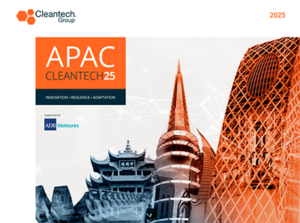Cleantech Companies to Watch from the Asia-Pacific Region
This quarter’s ‘Companies to Watch’ highlights companies that our guest investors from the region think our international audiences should know about.
Our guest contributions this month have highlighted two companies from South Korea—one a start-up and the other a public company—and one company from China.
The guest contributors were reacting to the open question:
“What cleantech company (or companies) from your country/region would you highlight to our international audiences at this time, and why?”

60Hertz (South Korea): Virtual Power Plant Solutions for Distributed Energy Resources
60Hertz offers AI-powered forecasting and orchestration software for distributed energy assets like rooftop solar and energy storage systems. Their platform forms the backbone of “virtual power plants” that stabilize grids with real-time optimization, which is essential as Asia transitions away from centralized fossil power.
As South Korea’s new administration prioritizes grid modernization and clean energy diversification, 60Hertz is at the center of what’s next for regional energy resilience. The government’s initiatives to enhance renewable energy integration and smart grid technologies create a conducive environment for 60Hertz’s solutions.
Internationally, 60Hertz’s platform is crucial for integrating renewable energy sources into existing grids, enhancing stability and efficiency in the global transition to clean energy. Their technology supports the development of resilient and flexible energy systems worldwide.
GridWiz is a South Korea-based energy technology company pioneering virtual power plant (VPP) solutions that intelligently manage distributed energy resources (DERs) such as rooftop solar, electric vehicle chargers, and battery storage. Leveraging AI-powered demand response and real-time energy orchestration, GridWiz enhances grid reliability while accelerating the transition to renewable energy.
As Korea pushes forward with its energy transition—marked by aggressive renewable targets, EV adoption, and smart grid modernization—GridWiz is positioned at the intersection of policy momentum and technological capability. The company’s Enernet platform serves as a digital bridge connecting end-user energy devices to utilities, enabling bidirectional flexibility critical to the next-generation power system.
The Korean government’s growing emphasis on energy digitalization, carbon neutrality, and VPP demonstration projects has created fertile ground for GridWiz’s expansion. The company has been an active partner in national-scale smart grid pilot zones and is a leading player in demand-side resource aggregation for Korea Electric Power Corporation (KEPCO) and the Korea Power Exchange (KPX).
Internationally, GridWiz is contributing to the global shift toward decentralized, intelligent energy systems. Its AI-enabled solutions are not only optimizing energy use and reducing carbon emissions but also empowering communities and businesses to become prosumers in resilient, climate-resilient power grids.
Gridwiz completed its IPO onto the KOSDAQ exchange in June 2024.
 PCG Power (China): Distributed Solar, Storage, and Virtual Power Plant Platforms for Commercial and Industrial Clean Energy
PCG Power (China): Distributed Solar, Storage, and Virtual Power Plant Platforms for Commercial and Industrial Clean Energy
One cleantech company from the Asia region I would highlight is PCG Power, one of China’s largest and fastest-growing developers and operators of distributed renewable energy assets and energy storage in the commercial and industrial sector.
PCG Power is significant for Asia because it provides several important learnings on how renewable energy can be deployed at much higher speed and scale, challenging the traditional developer status quo with a more agile and replicable model. The ability to deploy more quickly and reliably is especially needed in today’s environment where in Asia, grid demand is accelerating with greater electrification, and geopolitical shifts are driving the need for localized energy supply chains.
- Ultra-fast deployment at scale: PCG has developed over 2GW of projects so far and achieved almost 1GW connected to the grid within one year. That’s close to 200 projects—compare this to timelines for comparable projects by traditional players which take at least two years from project award to commissioning. This is achievable due to PCG Power’s repeatable, modular deployment model tailored for commercial and industrial versus the traditional one-off build, incorporating digital tools such as drone surveying and automated permitting.
_ - Innovative capital model: Compared to capital-heavy, centralized projects that require large upfront financing and are tied to PPAs with long tenors, PCG Power has been able to implement an asset-light structure through SPVs to scale distributed assets with arms-length infrastructure finance partners, enabling higher IRRs than traditional project developers.
_ - Digitally native operations from the outset: While traditional projects often underutilize digital infrastructure post-commissioning, PCG Power embeds digitalization throughout the entire lifecycle from site selection to O&M via tools such as its real-time Energy Management System (EMS). These tools enable predictive maintenance, second-level fault diagnosis, and active participation in electricity markets through Virtual Power Plant (VPP) capabilities, allowing PCG Power to maximize IRRs and long-term returns across its portfolio.
PCG Power is active in China and now expanding into overseas markets across Asia and the Middle East.



